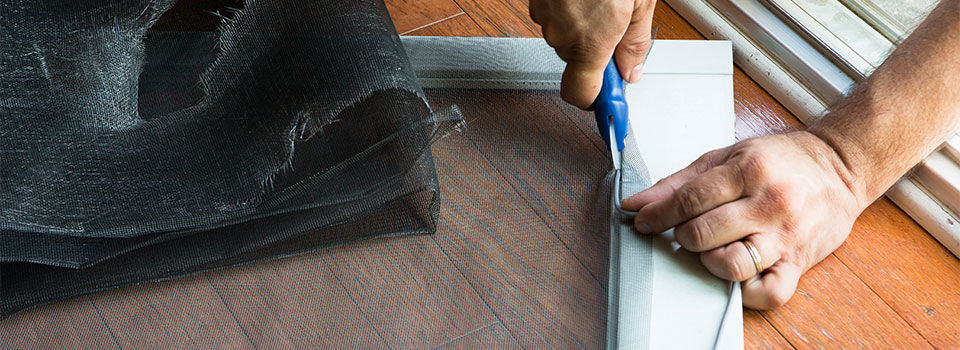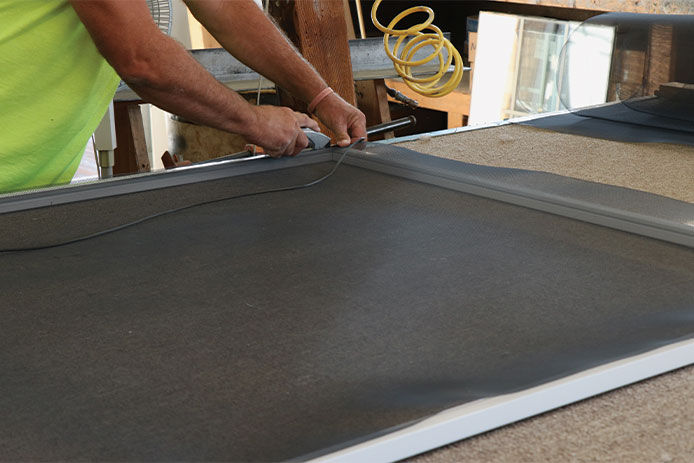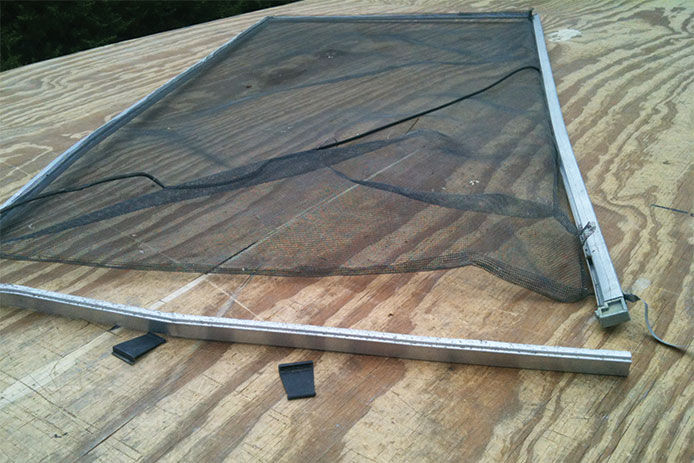While do-it-yourself projects can be fun and fulfilling, there is always a potential for personal injury or property damage. We strongly suggest that any project beyond your abilities be left to licensed professionals such as electricians, plumbers, and carpenters. Any action you take upon the information on this website is strictly at your own risk, and we assume no responsibility or liability for the contents of this article.
How to Repair and Replace Screens in Doors and Windows

You’re enjoying the breeze through an open window or screen door just to see a stray baseball punch through the material. Perhaps a rambunctious pet snags a nail in the screen material and leaves it with a massive rip. Don’t panic and assume you need professional repairs just to use your window or door screen again. With some patience and the right tools from a hardware store, it’s easier than you might think to repair or replace the damaged screen wherever it’s installed around your home.
Dab on Glue

If you spot tiny nicks and tears before they have time to widen into larger holes, it’s easy to repair the screen with any waterproof glue. Try to match the glue to the material, which is likely either fiberglass or aluminum. Clear silicone adhesives are a good choice for both types of screens. Make sure to use a glue that dries clear rather than amber or white since that will make the repair visible. Press down any lifted or unraveled bits of screen and brush the glue over both sides of the damaged area. This can likely be done while the screen is still in the window or door, unlike other more substantial repairs.
Apply a Patch

Need to seal up a small rip or hole that is just a few inches across? A patch of matching screen material is likely all you need. For rips and holes below 2 inches in width, you can likely apply the patch while the screen is still in place. Larger rips and holes are better patched with the framed screen removed from the window or door, if possible. Full adhesive patches are available in a variety of sizes and screen styles, but you can also cut your own patch and glue it on with the waterproof glue recommended above.
Remove and Replace Damaged Screens

When the rip or tear in your window screen is more than a few inches long, you’re better off just replacing the screen material. Doors often need a new screen even for relatively small tears because they’re even harder to patch in place due to the larger size and reduced tension. It’s easy enough to pull the old screen loose and press a new sheet in place, as long as you’re patient and take your time.
Windows

The method for replacement depends largely on the type of window screen you have on your home.
Molding Frames
Molding frames are an older style of window screen that feature a wide wood frame that the screen is simply stapled on. Replacement is as simple as gently prying up the old staples to remove the screen and carefully stapling on a new piece. Measure the frame to ensure the new piece of screen overlaps the inner measurement of the molding by half an inch. Use a staple gun or small trim nails to attach the new screen, starting at one corner and working on opposite sides as you go down to keep the tension even across the material.
Channel Frames
Most modern windows feature channel frame screens that have a relatively thin metal edge. You’ll notice the screen tucks into this edge and is secured by a small strip of plastic known as a spline. Start your replacement by using a sharp tool like a screwdriver or long nail to pry up one corner of the spline. Pull them all out, then lift the damaged screen away from the frame.
If you plan to use a metal screen, you’ll need a tool known as a spline roller to make the installation easy. Cut the screen to overlap the frame by half an inch and then line it up. Roll the small tool, which looks like a miniature pizza cutter, down the spline channels to crimp the material so it’s easy to secure with the new splines. This isn’t necessary with fiberglass and other synthetic screens because they’re thinner and easier to bend.
Once the screen is laid out and prepared, if necessary, grab a piece of new spline and cut it to match one edge of the frame. Use the spline roller to start working it into the small channel in the frame, pressing the screen down as you work. Start with the top, then complete one side followed by the opposite one, maintaining as much tension as you can. If wrinkles form, you have to lift one side of the spline and start over. Finish with the bottom edge and check the fit of the new screen.
Doors

Screen doors follow the same procedure as window screens, but they do take a little more work to remove due to their hinges. Trying to apply a new screen while a door is mounted will only lead to frustration and a wrinkly installation. Screen doors also fall into either molding or channel-style frames, so simply find the matching style and follow the instructions.
Don’t have ripped screens let bugs in or keep you from opening the windows. Whether you just need a small patch or a whole new window screen, these tips will help you accomplish the job.